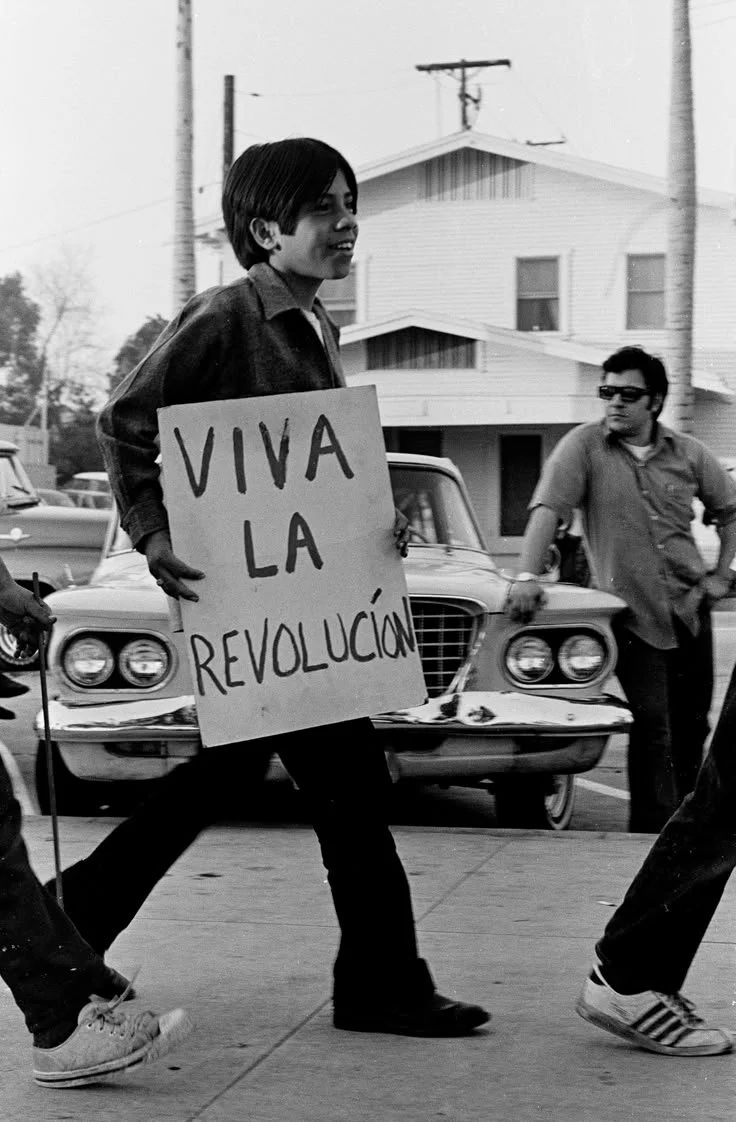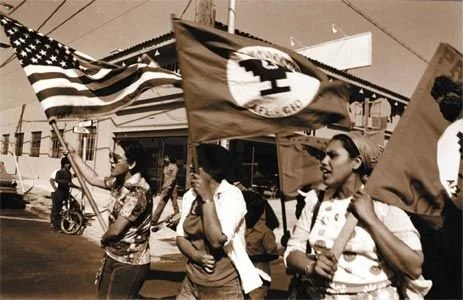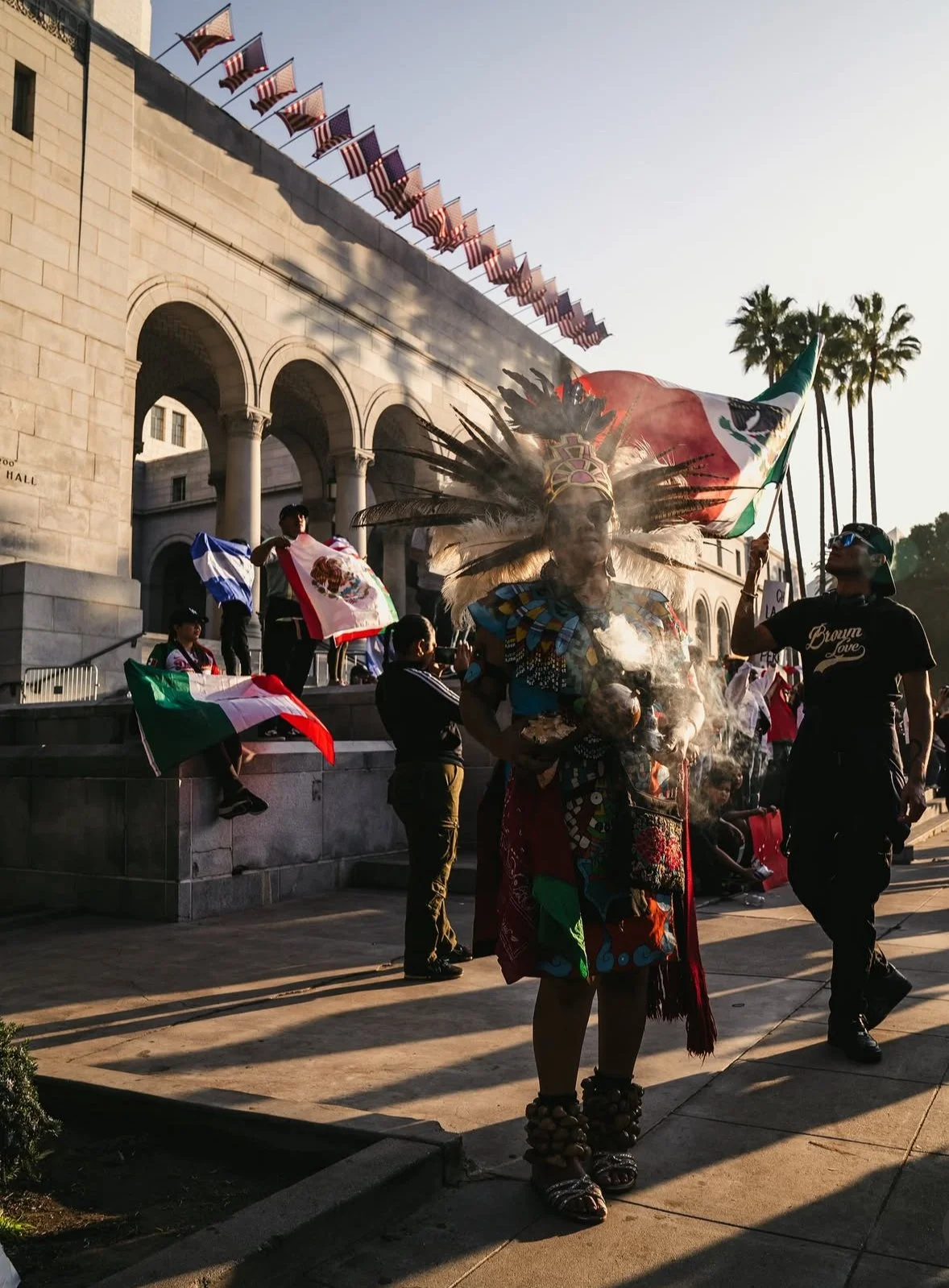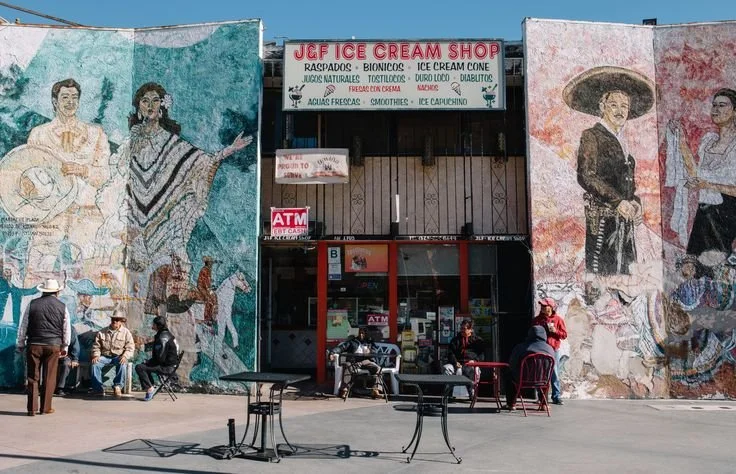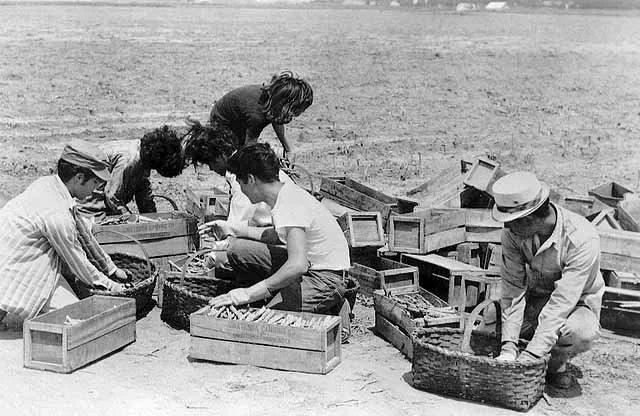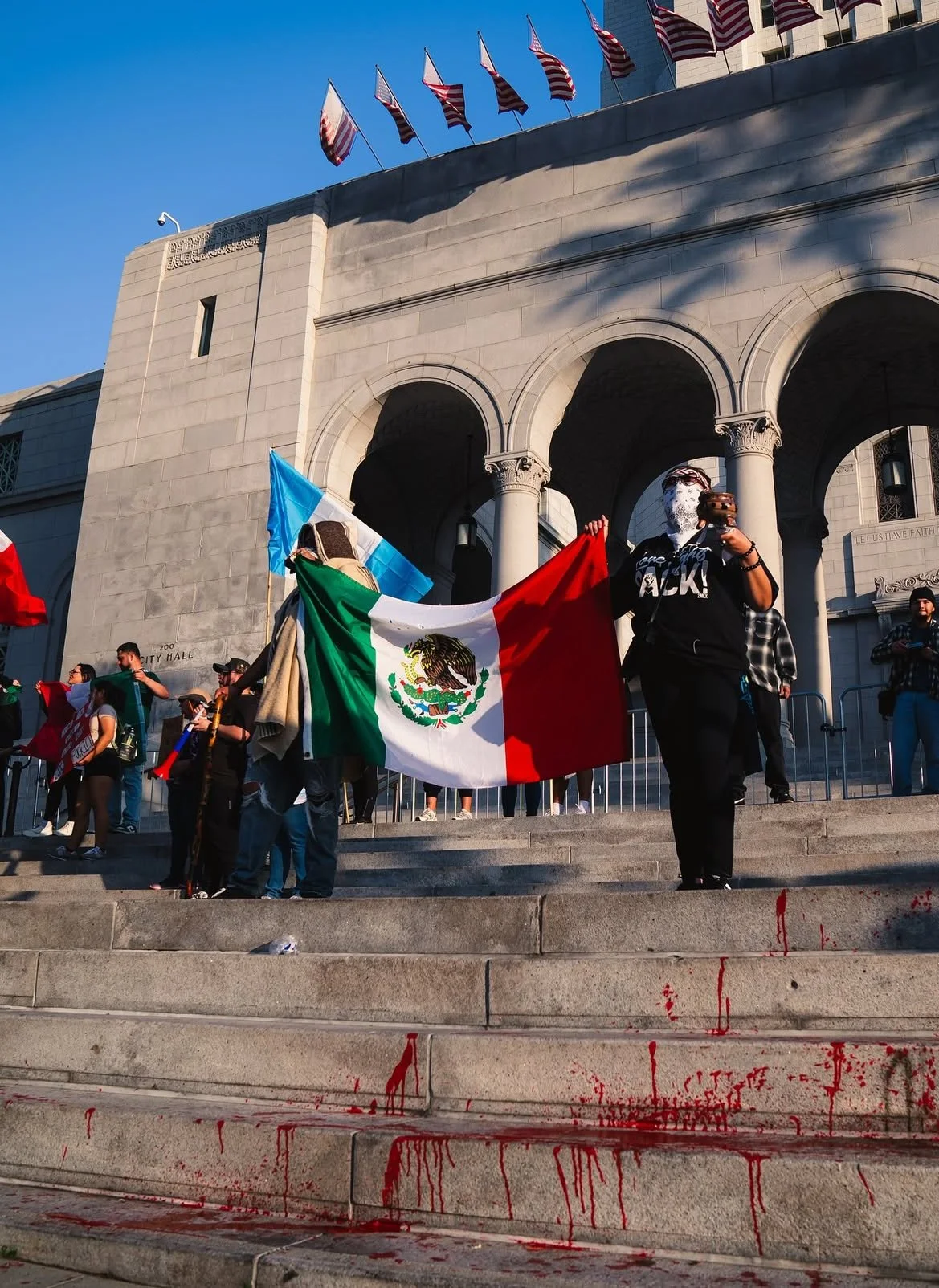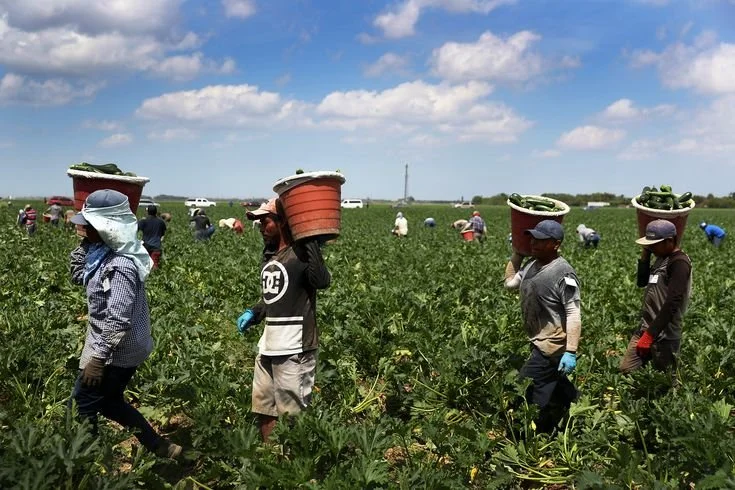Ancestry on Stolen Land: ICE, Labor, and the American Contradiction
By Natalie McCarty
Like many cities all across the United States, Los Angeles wakes early. The city’s pulse is set by workers who slip out before dawn: day laborers at a Home Depot parking lot in Westlake, janitors leaving Boyle Heights apartments with mops in hand, farmworkers packed into vans headed north toward Ventura’s fields. Their ancestry spans continents and centuries, yet their labor keeps this city, this state, this country alive.
It is in the work, the resilience, and the contributions of these immigrants that I see the truest face of America. They make me proud to be an American. To be a neighbor. An Angeleno. A community member. A human.
Viva La Revolución. Circa 1968 by Pedro Arias.
And still, the government treats them like a terrorist threat. ICE vans arrive in the same predawn hours as the workers—not to build the future of this country, but to fracture it, shattering families and leaving trauma in their wake. A knock on the door, a raid at the school bus stop, a factory floor emptied in minutes. Under the Trump administration’s latest crackdowns, Los Angeles has become a stage for America’s enduring contradiction: a nation that depends on immigrant labor while trying to erase immigrant presence.
It is an old story dressed in new uniforms. Before ICE agents carried zip-ties, soldiers carried muskets. Before detention centers, there were missions and reservations. The land itself—Tongva, Chumash, Ohlone—was stolen long before today’s raids, yet the descendants of that theft wield the law to dismantle communities, families, and futures as if showing up were a crime. Spoiler alert: it is not.
What follows is a chronology of raids and court battles, of crops left to rot and classrooms hollowed out by fear, of a nation addicted to immigrant labor but allergic to immigrant presence. It is a story of ancestry on stolen land, and of the labor that refuses to disappear, even when the state tries its hardest to erase it.
Image Sourced through Pinterest
The Raids and the Legal Whiplash
The summer of 2025 brought Los Angeles back into ICE’s crosshairs with an intensity not seen since the Trump years began.
June 6, 2025: The first wave slammed the city’s immigrant neighborhoods. ICE and DHS teams stormed the Fashion District, arrested workers at a Home Depot lot in Westlake, and emptied a clothing wholesaler mid-shift. Forty-four people were detained, including Daniel Huerta, president of SEIU California, who had joined a protest on site. Demonstrators faced flash-bang grenades and tear gas.June 6–22: In just two weeks, federal agencies detained nearly 1,200 people, part of 1,618 total arrests across L.A. that month.July 10, 2025: ICE descended on a Camarillo greenhouse in Ventura County, arresting more than 200 workers. In the chaos, Jaime Alanis Garcia fell from a rooftop while fleeing and later died—a human cost reduced in press releases to a footnote.Mid-July 2025: Civil-rights groups filed suit. Judge Maame E. Frimpong issued a temporary restraining order banning raids based on race, language, occupation, or location. Enforcement dropped sharply.August 26, 2025: Homeland Security Secretary Kristi Noem announced 5,000 arrests in L.A. since June, casting the campaign as the removal of “the worst of the worst.” Local reporters quickly uncovered that the majority of those arrested had no criminal convictions.September 8, 2025: In a 6–3 shadow-docket ruling, the Supreme Court lifted Frimpong’s injunction. Justice Brett Kavanaugh argued race, language, and occupation could contribute to “reasonable suspicion.” Justice Sonia Sotomayor’s dissent warned the ruling legalized racial profiling. Raids resumed almost immediately.
Los Angeles became the proving ground for how far ICE could push constitutional limits, and how quickly the courts would let them. It is a grotesque and devastating indictment of our nation’s humanity.
Who ICE Really Arrested
The DHS press releases talked of “violent criminals,” “gang members,” and “drug traffickers.” But the numbers tell a different story.
69% of those arrested had no criminal convictions.58% had never been charged with any crime at all.
The so-called “worst of the worst” turned out to be garment workers, day laborers, nannies, and fathers pulled from minivans on their way to work. ICE’s dragnet blurred the line between civil immigration violations and criminality until the two became indistinguishable to the public.
This wasn’t about law and order. It was about making immigrant life precarious, about reminding workers that the knock on the door could come at any hour. The Trump administration aims to keep you fearful and isolated.
Image Sourced through Pinterest
The Economics of Disappearance
When ICE raids, the ripples are felt in markets and harvests as well..
In Ventura County, 25–45% of farmworkers stopped showing up in July 2025, leaving rows of strawberries and peppers to rot.Economists estimate a 20–40% drop in ag labor statewide, causing $3–7 billion in crop losses and price spikes of up to 12% on produce.California’s private-sector workforce shrank 3.1% during the raids—comparable to the freefall of the COVID-19 recession.Immigrants contribute nearly 5% of California’s GDP; undocumented workers make up 8% of the state’s jobs.
Even the Trump administration, facing farm-lobby backlash, quietly rolled back agricultural enforcement in August 2025 to keep crops moving. The contradiction was glaring: a government criminalizing immigrant labor while depending on it to feed the country.
Trauma in the Classroom
As if fear of school shootings and gun violence against our youth wasn't enough, America made it even more apparent that they care not for the fear that children carry into their classrooms.
A Stanford study found that immigration raids trigger 22–30% spikes in absenteeism in districts with large immigrant populations. Teachers reported sudden drop-offs in performance; students broke down in tears mid-lesson after learning a parent hadn’t come home.
Clinics in Los Angeles recorded surges in stress-related illnesses. Psychologists documented PTSD-like symptoms among children as young as six. ICE eliminates all stability from households and childhoods.
Legal Precedent and the Supreme Court’s Green Light
Judge Frimpong’s injunction in July 2025 had briefly reined in ICE, limiting racial and occupational profiling. But the Supreme Court’s shadow-docket reversal two months later signaled a seismic shift.
Justice Kavanaugh’s opinion reframed race, language, and occupation as “contextual factors,” essentially endorsing tactics that civil-rights lawyers compared to Jim Crow policing. Justice Sotomayor’s dissent argued the ruling hollowed out the Fourth Amendment for millions of immigrants and citizens alike.
For farmworkers and day laborers, the ruling cemented their vulnerability. Without papers and without contracts, they had little legal recourse. The ruling functionally made poverty itself suspicious.
Image Sourced through Pinterest
The Invisible Rights of Farmers and Day Laborers
America’s dependence on immigrant labor has never translated into full rights. Farmworkers are excluded from many federal labor protections. Day laborers, often hired off sidewalks or lots, work without contracts, unemployment insurance, or safety nets.
Advocates propose:
Unemployment benefits regardless of immigration status.State wage-theft enforcement that doesn’t trigger ICE involvement.Legal aid funding to ensure representation in immigration court. Legal aid funding to ensure representation in immigration court.
The MAGA agenda and its enforcers want you to think that these aren’t radical asks when, in reality, they’re acknowledgments that the labor keeping America fed deserves more than surveillance and deportation. Immigrants are the backbone of our country.
Resistance Networks and Street-Level Solidarity
Los Angeles continues to push back.
Sanctuary churches opened their doors to families on ICE’s radar.Teenagers in Boyle Heights and South Central used group chats to warn neighbors of vans spotted in the area.Hotlines staffed by volunteers provided real-time legal counsel during raids.
On July 10, the death of Jaime Alanis Garcia in Oxnard galvanized protests across Ventura and L.A. Hundreds marched, holding signs that read “Work Is Not a Crime” and “ICE Kills.”
Even as the federal government escalated enforcement, communities turned fear into resistance, refusing to vanish. ¡Si Se Puede!
The Politics of Enforcement
ICE’s aggressive return was shepherded by figures like Gregory Bovino, a career officer known for hard-line tactics. Secretary of Homeland Security Kristi Noem framed the raids as “law and order,” but critics pointed to the political theater of high-profile sweeps.
By late summer, even conservative agricultural leaders pressed for exemptions to keep farms staffed. Trump’s August rollback for agricultural and hospitality sectors was framed as pragmatism but exposed the hypocrisy at the heart of the policy: deportation until deportation hurts profits.
The American Contradiction
ICE can detain, deport, and terrify. What it cannot do is erase the ancestry carried by every worker, every child, every family targeted. Their roots predate borders. Their labor builds the very country that seeks to expel them.
The contradiction is as old as America: a nation founded on stolen land, fueled by stolen labor, forever seeking to deny the people who sustain it.
And yet, the beauty persists. In kitchens where pupusas still sizzle despite raids. In classrooms where children learn to conjugate verbs in two languages. In fields where, against all odds, strawberries still make it to market.
History will remember who truly built this country.
Image Sourced through Pinterest
Sources
NBC Los Angeles, June 6, 2025 — Reporting on Fashion District, Home Depot, and wholesale raids; Daniel Huerta arrest.
Los Angeles Times, June 22, 2025 — Coverage of 1,618 arrests and National Guard deployments.
ABC7 News, July 10, 2025 — Coverage of Oxnard greenhouse raid and death of Jaime Alanis Garcia.
Los Angeles Times, July 2025 — Judge Frimpong injunction details.
Politico, Aug. 26, 2025 — DHS Secretary Kristi Noem announces 5,000 arrests.
LAist / Los Angeles Times investigations — Data on 69% with no convictions, 58% never charged.
Supreme Court ruling, Sept. 8, 2025 — Majority opinion by Justice Kavanaugh; dissent by Justice Sotomayor.
Ventura County Star, July 2025 — Reporting on 25–45% drop in farm attendance.
UCLA/UC Davis study, 2025 — Estimated $3–7 billion losses and produce price spikes.
Financial Times, July 2025 — Reporting on 3.1% private-sector workforce drop.
Public Policy Institute of California, 2025 — Immigrant GDP contribution and undocumented job share.
Washington Post, Aug. 2025 — Trump rollback on ag/hospitality enforcement.
Stanford University, 2023 — Study on raids and school absenteeism.
American Psychological Association, 2024 — Research on mental health impacts of immigration enforcement.
California Immigrant Policy Center, 2025 — Policy proposals for labor rights protections.
Los Angeles Times, July 2025 — Reporting on Gregory Bovino’s leadership of ICE operations in California.

